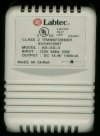The
Power Supply and Misc. Measurements
I must gripe
about the giant wall wart. It's...giant. You will have to give it a solitary
spot on your strip or use a cheap $1.99 extension cord if power strip space
is at a premium. The second gripe is that under heavy load, it gets so hot
that you could burn yourself if leaning up against it. Actually, a more realistic
possibility is what it might heat up forgotten on the floor behind a desk
of some sort. Be careful where you put this thing.
As we figured
out, the unit is rated at 14.4 watts. After that, any stronger current requirements
decrease the output voltage, increase the hiss and distortion. A larger filter
capacitor would solve this dilemma. As I did not attempt a two-tone test (i.e.
100Hz and 1 KHz), the power supply table reflects only two of the three output
channels fully driven. The house AC input measured 119 Volts.
|
DC
Voltage
|
Load
|
Description
|
|
16.80
|
None
|
not
plugged into sub
|
|
16.10
|
Idle
|
plugged
into sub w/no music
|
|
14.86
|
1
channel
|
3.67
watt, 1 channel draw
|
|
14.83
|
2
channels
|
6.52
watt, 2 channel draw
|
With both sat channels
at maximum, the total current draw exceeds 1 amp and the wart is seriously
stressed. Adding the power hungry sub to the equation could easily have the
current near the 3 amp mark. Current limiting is heard as the familiar "pumping
and breathing" or just flat out distortion.
The signal to noise ratio,
or the amount of hiss that emits from the speakers was a very high 79dBC at
max volume measured from the satellite outputs. No appreciable hiss or hum
was heard at any volume setting.
The analog volume control
fits in your hand nicely. It has a twofold purpose: loudness and input impedance.
Rather than the ubiquitous hashy sounding digital volume control (they all
have distortion), Labtec has a volume "pickle." Similar to those
game show hand-held buttons, this one is very small and sports a side mounted
potentiometer that operates smoothly and precisely. It feels more expensive
than it should.
Input Z (impedance) is
the resistance that the position of the volume control sends back to the amplifiers.
Effectively controlling loudness, if the Z is too low, it will load down the
music source, in this example the sound card. The measured input Z was 5.35Kohms.
This figure will keep noise figures lower than if a 10Kohm pot was used, but
it could load cheap sound cards. Nominally, if the input impedance is at least
10 times the output impedance of your sound card, less than 1dB of sound will
be lost and very little high frequency loss will occur. Many cards in the
$10-$20 range have output impedances of 1KHz or more, which could cause problems
with these Edge 418's. The Sound Blaster Live! card I used for testing has
a much lower output impedance and was a great match for the volume control.
Speaking of the SBLive!,
it's usually known as a high quality, high output card. So when I had to boost
the device mixer input to max as well as the master volume, I was inclined
to check the amplifier input requirements. I found that a high-ish 240mV was
needed to drive the 418's to full output. Some sound cards definitely will
not meet this requirement.
Miscellaneous
Pictures
|
Accessories
|
Directions
|
Monitor
Mount
|
Table
Mount
|
|
|
|
|
|
